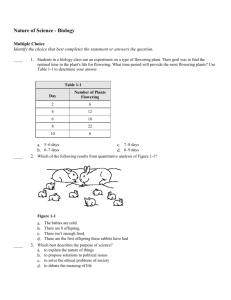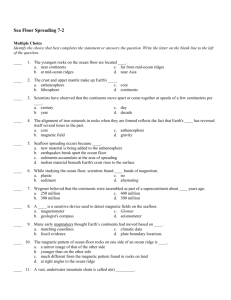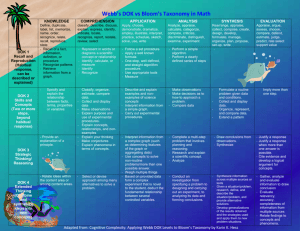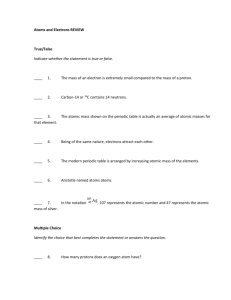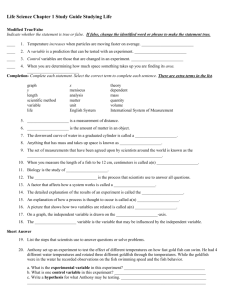Ch3 Biomes
advertisement
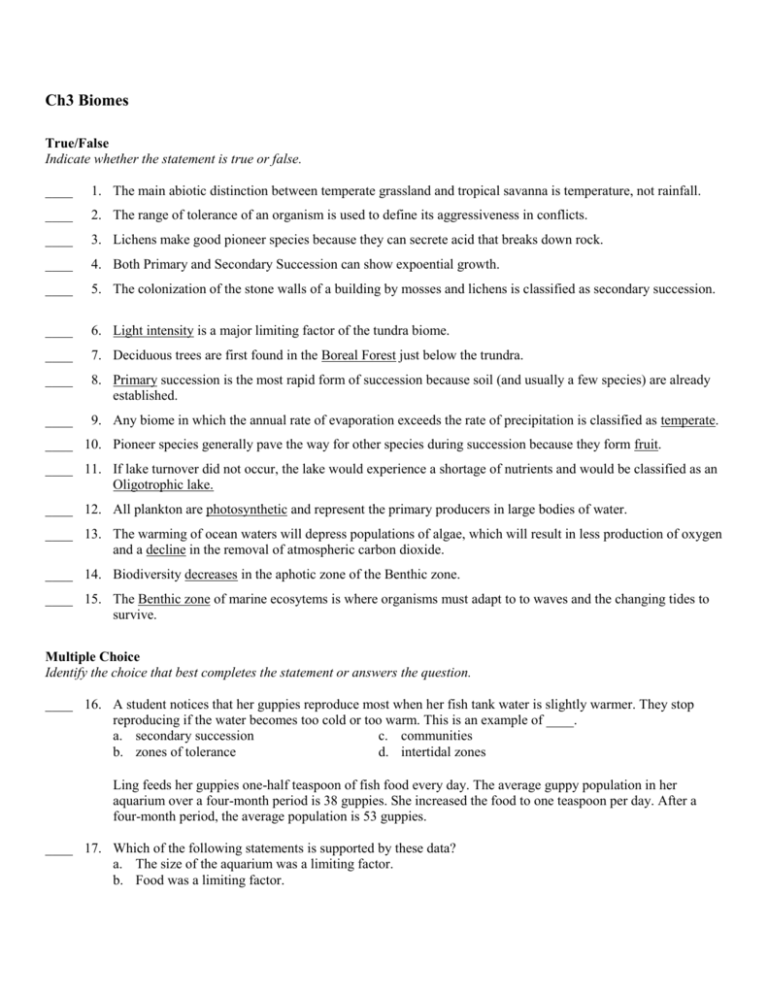
Ch3 Biomes True/False Indicate whether the statement is true or false. ____ 1. The main abiotic distinction between temperate grassland and tropical savanna is temperature, not rainfall. ____ 2. The range of tolerance of an organism is used to define its aggressiveness in conflicts. ____ 3. Lichens make good pioneer species because they can secrete acid that breaks down rock. ____ 4. Both Primary and Secondary Succession can show expoential growth. ____ 5. The colonization of the stone walls of a building by mosses and lichens is classified as secondary succession. ____ 6. Light intensity is a major limiting factor of the tundra biome. ____ 7. Deciduous trees are first found in the Boreal Forest just below the trundra. ____ 8. Primary succession is the most rapid form of succession because soil (and usually a few species) are already established. ____ 9. Any biome in which the annual rate of evaporation exceeds the rate of precipitation is classified as temperate. ____ 10. Pioneer species generally pave the way for other species during succession because they form fruit. ____ 11. If lake turnover did not occur, the lake would experience a shortage of nutrients and would be classified as an Oligotrophic lake. ____ 12. All plankton are photosynthetic and represent the primary producers in large bodies of water. ____ 13. The warming of ocean waters will depress populations of algae, which will result in less production of oxygen and a decline in the removal of atmospheric carbon dioxide. ____ 14. Biodiversity decreases in the aphotic zone of the Benthic zone. ____ 15. The Benthic zone of marine ecosytems is where organisms must adapt to to waves and the changing tides to survive. Multiple Choice Identify the choice that best completes the statement or answers the question. ____ 16. A student notices that her guppies reproduce most when her fish tank water is slightly warmer. They stop reproducing if the water becomes too cold or too warm. This is an example of ____. a. secondary succession c. communities b. zones of tolerance d. intertidal zones Ling feeds her guppies one-half teaspoon of fish food every day. The average guppy population in her aquarium over a four-month period is 38 guppies. She increased the food to one teaspoon per day. After a four-month period, the average population is 53 guppies. ____ 17. Which of the following statements is supported by these data? a. The size of the aquarium was a limiting factor. b. Food was a limiting factor. c. As long as Ling keeps adding more food, the guppy population will continue to grow. d. Guppies reproduce rapidly. Figure 3-1 ____ 18. In Figure 3-1, where will you most likely find the greatest diversity? a. A c. C b. B d. D ____ 19. In Figure 3-1, which section would have a lack of organisms due to an overabundance of resources? a. A c. C b. B d. D ____ 20. In Figure 3-1, which section would account for a lower number of organisms near the bottom of a pond due to a short supply of oxygen and sunlight? a. A c. C b. B d. D ____ 21. What type of succession is most likely to happen in Figure 3-2? Figure 3-2 a. primary c. tertiary b. secondary d. climax ____ 22. At which stage in Figure 3-3 are the most pioneer species found? Figure 3-3 a. A b. B c. C d. D Figure 3-4 ____ 23. Look at the graph in Figure 3-4. What does this graph tell us about this species of plant? a. Too much sunlight can hurt them. b. They thrive in a lot of sun. c. Heat is damaging to them. d. They need plenty of water. ____ 24. What would be the best time of the year to plant the organism described in Figure 3-4? a. winter c. summer b. spring d. fall Figure 3-5 ____ 25. You take a sample of species from the area labeled A in Figure 3-5. What would you expect to find? a. almost no life b. great species diversity c. organisms that need very little oxygen d. one dominant species of fish ____ 26. What type of species would be most likely found in the area labeled D in Figure 3-5? a. one that requires plenty of oxygen b. plants that require light c. amphibians that need a warm habitat d. decomposers that feed on dead organisms ____ 27. What single feature is primarily responsible for the variation of climate in different parts of the world? a. intensity of wind b. angle of incoming sunlight c. length of daylight d. amount of precipitation ____ 28. If the global warming trend continues and permafrost under the tundra melts, what biome would you predict would replace it? a. boreal forest c. temperate grassland b. temperate forest d. desert ____ 29. If you were dropped off on the North American continent at a latitude of 40° N, which of the following climate zones would you discover there? a. polar c. temperate b. tropical d. arctic ____ 30. If precipitation on a tropical savanna increased from 100 to 200 centimeters per year but temperature remained the same, what biome would replace the savanna? a. tropical rain forest c. tropical seasonal forest b. temperate forest d. temperate rain forest ____ 31. If fire were suppressed on a temperate grassland, what species do you think would increase in number? a. trees c. herbs b. grasses d. bison ____ 32. Which of the following effects on the climate would you infer would result from an increase in altitude? a. the same as an increase in precipitation b. the same as a decrease in precipitation c. the same as a decrease in latitude d. the same as an increase in latitude Imagine you are an ecologist called in to investigate a problem with a lake in a city park. The lake was once clear but is now eutrophic, with green slime floating on it and a fetid odor. ____ 33. Personnel from the parks department have investigated the problem and present you with the following theories. Weigh the evidence and decide which is the best explanation for the problem. a. An unusually warm spring resulted in a delayed overturn of the lake so nutrients in the water are limited. b. Native carp in the lake are stirring up the bottom with their feeding activities, making the water cloudy. c. Fertilizer from park lawns has run off into the water, adding too many nutrients to the system. d. Algae are overgrowing in the water because it is warmer than usual this year. ____ 34. Which of these species would you classify as a profundal zone organism? a. frog c. crayfish b. plankton d. floating water plants A team of ecologists measured the salinity of the water in an estuary at various distances from the river mouth. They also sampled populations of two species of clam worm, Nereis occidentalis and Neanthes succinea, at each point. The results are tabulated below. Table 3-1 ____ 35. Which of the following hypotheses is most valuable in explaining the trends seen in the data? a. Nereis occidentalis outcompetes Neanthes succinea at salinities under 14‰. b. Neanthes succinea reproduces most rapidly in areas at least 20 meters from the river mouth. c. Both Neanthes succinea and Nereis occidentalis can survive at any salinity. d. Nereis occidentalis is more resistant to salinity than Neanthes succinea. ____ 36. If the ecologists were to take a population sample of Neanthes succinea in an area 65 meters from the river mouth with 30‰ salinity, what do you infer that they would find? a. 40–50 individuals b. 10–20 individuals c. fewer than 5 individuals d. more than 50 individuals ____ 37. Imagine you are listening to a series of student presentations in which the speakers hypothesize about the kinds of marine life they would expect to find in an abyssal marine zone. Which hypothesis do you find most compelling? a. Autotrophic organisms like seaweed and plankton will be common, along with many larger organisms supported by these producers. b. Coral reefs and high species diversity are expected, with many kinds of fish and invertebrates. c. Large open-ocean fish will live there, like tuna, marlin, and sharks. d. Low species diversity is predicted, except around hydrothermal vents where bacteria, fish, and crabs live. ____ 38. Some coral reefs off the east coast of South America are starting to die off. Satellite images reveal great plumes of sediment washing out of the mouths of rivers. What can you conclude, if anything, about the relationship between these two factors? a. Although the two factors coincide, they are not likely to be related. b. Deforestation on land results in lower oxygen levels in the atmosphere, which stresses the reef. c. Deforestation on land allows erosion to wash away topsoil, which smothers reefs. d. Burning of the rain forest increases atmospheric carbon dioxide to levels toxic to reefs. ____ 39. Analyze each of the sequences in the primary succession of species colonizing a newly formed volcanic island and select the option in the correct order. a. bare rock, small annual plants, lichens, shade-intolerant trees, shade tolerant trees b. bare rock, lichens, small annual plants, perennial herbs and grasses, shade intolerant trees c. bare rock, lichens, perennial herbs and grasses, small annual plants, shade intolerant trees d. bare rock, lichens, small annual plants, perennial herbs and grasses, shade tolerant trees ____ 40. Which of these species might be classified as a pioneer species? a. ponderosa pine c. aspen b. choke cherry d. lichen ____ 41. What is the distinction between a zone of tolerance and limiting factors? a. Limiting factors are biotic or abiotic factors that limit the growth of a species, while the range of tolerance defines the set of conditions in which an organism can survive. b. The range of tolerance defines biotic or abiotic factors that limit the growth of a species, while limiting factors define the set of conditions in which an organism can survive. c. Limiting factors and zones of tolerance are two terms for the same concepts about species survival under various environmental conditions. d. Limiting factors are biotic features only, such as interactions with other life forms, that limit a species, while range of tolerance is based only on abiotic conditions. ____ 42. Compare primary and secondary succession. What is the distinction between them? a. Primary succession is the sequence of species that become established early in a newly colonized area, and secondary succession is the sequence of species that move in later. b. Primary succession is the establishment of a community in an area with no soil, while secondary succession is the establishment of a new community in an existing ecosystem that was disturbed. c. Primary succession is the establishment of a new community in an existing ecosystem that was disturbed, while secondary succession is the establishment of a community in an area with no soil. d. Primary succession is the sequence of plants that colonize a new area, while secondary succession is the sequence of animals that move in later. ____ 43. A place at 2° N latitude has an average annual temperature of –6° C. What can you conclude about the environment? a. It is cold, so it must be in the northern polar region. b. Nothing can be concluded except the information given. c. It is at a very high altitude. d. It must be submerged at the bottom of a deep ocean to be equatorial and so cold. ____ 44. How would you classify a biome having forest with broad-leaf evergreen trees, mosses, and orchids, 20–25° C temperatures, and where the >200 cm of rainfall per year is seasonal? a. tropical seasonal forest c. tropical rain forest b. tropical savanna d. temperate woodland Ch3 Biomes Answer Section TRUE/FALSE 1. ANS: T PTS: 1 DIF: Bloom's Level D | DOK 1 REF: 66 | 70–71 NAT: LS_5e STA: LS.10.15 TOP: 3-6 2. ANS: F Range of tolerance is the range of values of a biotic or abiotic factor within which an organism can live and reproduce. PTS: 1 DIF: Bloom's Level B | DOK 1 REF: 61 NAT: LS_5e STA: LS.10.16 TOP: 3-1 3. ANS: T PTS: 1 DIF: Bloom's Level B | DOK 2 REF: 62 TOP: 3-3 4. ANS: T PTS: 1 DIF: Bloom's Level E | DOK 2 REF: 61 NAT: LS_5e STA: LS.10.16 TOP: 3-2 5. ANS: F This would be a primary succession process. PTS: 1 NAT: LS_4c DIF: Bloom's Level C | DOK 2 TOP: 3-3 REF: 62–63 MODIFIED TRUE/FALSE 6. ANS: F Temperature Cold arctic temperatures slow plant growth, limiting the forage available to grazers. PTS: 1 DIF: Bloom's Level A | DOK 2 REF: 68 NAT: LS_5e STA: LS.10.16 TOP: 3-1 7. ANS: F secondary The distinction between primary and secondary succession is whether soil is present for the pioneer species. In this ecosystem, fire is the most common disturbing force, so soil remains mostly intact. PTS: 1 DIF: Bloom's Level B | DOK 2 REF: 63 NAT: LS_4c STA: LS.12.8 TOP: 3-3 8. ANS: F Secondary Recall that primary succession is the establishment of a new community on bare rock or sand with no soil. PTS: 1 DIF: Bloom's Level B | DOK 2 NAT: LS_4c STA: LS.12.8 TOP: 3-3 9. ANS: F desert This is the definition of a desert. REF: 64 PTS: 1 DIF: Bloom's Level D | DOK 2 REF: 70 TOP: 3-6 10. ANS: F soil Pioneer species like mosses or lichens make soil by breaking down rock and forming humus when they die. PTS: 1 DIF: Bloom's Level E | DOK 2 REF: 63 NAT: LS_4c TOP: 3-3 11. ANS: T PTS: 1 DIF: Bloom's Level D | DOK 2 REF: 76 NAT: LS_1e STA: LS.10.16 TOP: 3-8 12. ANS: F Many fish and marine invertebrates like crabs use mangroves as nurseries for their young. PTS: 1 DIF: Bloom's Level F | DOK 2 REF: 78 NAT: LS_4c STA: LS.10.15 TOP: 3-9 13. ANS: T A large proportion of the planet's oxygen comes from marine algae, which also use up many tons of carbon dioxide. PTS: 1 DIF: Bloom's Level C | DOK 2 REF: 79 NAT: LS_1e STA: LS.10.9 TOP: 3-7 14. ANS: T light Not enough light penetrates those zones to support photosynthesis. PTS: 1 DIF: Bloom's Level F | DOK 2 NAT: LS_5e STA: LS.10.16 TOP: 3-7 15. ANS: F, pelaigec or intertidal zone PTS: 1 TOP: 3-10 DIF: Bloom's Level F | DOK 2 REF: 80 REF: 81 MULTIPLE CHOICE 16. ANS: B A zone of tolerance is the range of values of a factor within which organisms can live and reproduce. Feedback A B C D See definition of secondary succession on p. 63. Correct! Review communities on p. 60. Intertidal zones are places where ocean meets land, not in fish tanks. PTS: 1 DIF: Bloom's Level B | DOK 2 REF: 61 NAT: LS_5e STA: LS.12.8 TOP: 3-1 17. ANS: B A limiting factor can be identified from the fact that when it is provided in abundance a population grows. Feedback A B C D Aquarium size was not changed. True. Think it over and try again. Although the statement itself is true, it was not the idea being tested in the experiment. PTS: 1 DIF: Bloom's Level F | DOK 2 REF: 61 NAT: LS_4d STA: LS.10.16 TOP: 3-1 18. ANS: C Section C is the most favorable environment with respect to this factor. Feedback A B C D At limits of range, fewer species can survive. Close, try again. Right! At the upper limit of tolerance, fewer species can adapt. PTS: 1 DIF: Bloom's Level C | DOK 2 REF: 61 NAT: LS_4c STA: LS.10.16 TOP: 3-2 19. ANS: D The overabundance of the factor is on the right end of the range at section D. Feedback A B C D This end of the graph represents fewer resources. Don't give up. Organisms are plentiful here. Right answer! PTS: 1 DIF: Bloom's Level C | DOK 2 REF: 61 NAT: LS_4d STA: LS.10.16 TOP: 3-2 20. ANS: B Section A is not supportive of life; section B represents an underabundance of the factor, for example oxygen or sunlight. Feedback A B C D Section A represents a place nearly devoid of life. Correct. The highest point of the bell curve, at C, indicates an environment with the most organisms. This point of the curve represents a place with plentiful resources. PTS: 1 DIF: Bloom's Level C | DOK 2 NAT: LS_5e STA: LS.10.16 TOP: 3-2 21. ANS: B Secondary succession occurs after a fire disturbance. Feedback A B C Check definition of primary succession on page 62. Correct! Re-read the section on succession and try again. REF: 61 D Check the definition of a climax community on page 63. PTS: 1 DIF: Bloom's Level A | DOK 2 NAT: LS_4c STA: LS.12.8 TOP: 3-3 22. ANS: A Pioneer species are the first species to appear in a succession. REF: 62–63 Feedback A B C D That's right! There would be some, but not the most, here. Have a look at pages 62–64 again. There would be the fewest here. PTS: 1 DIF: Bloom's Level C | DOK 2 REF: 62–64 NAT: LS_4c STA: LS.12.8 TOP: 3-3 23. ANS: A As the sunlight increases, the rate of growth slows (it takes longer to grow). Feedback A B C D True. How much is "a lot"? Re-read the axes of the graph. Are we measuring heat? Does the graph indicate water quantities? PTS: 1 NAT: LS_5e 24. ANS: C DIF: Bloom's Level C | DOK 2 STA: LS.10.16 TOP: 3-1 REF: 61 Feedback A B C D Days are shortest in winter. Not bad, but when are days the longest? Correct answer. Days are getting shorter in the fall. PTS: 1 DIF: Bloom's Level E | DOK 2 REF: 61 NAT: LS_5e STA: LS.10.16 TOP: 3-2 25. ANS: B The most resource-rich and physically heterogeneous environment is the littoral zone. Feedback A B C D Think about the conditions there and try again. Good job. Little oxygen? At the surface? Many species could adapt to this environment. PTS: 1 DIF: Bloom's Level D | DOK 2 REF: 61 NAT: LS_5e TOP: 3-2 26. ANS: D This region receives a steady drift of waste materials and dead organisms. Feedback A B C D More oxygen is found closer to the surface. Less light reaches the bottom. Because less light penetrates, bottoms of lakes and ponds are cold. Right answer. PTS: 1 DIF: Bloom's Level B | DOK 2 REF: 61 NAT: LS_4b STA: LS.10.9 TOP: 3-2 27. ANS: B Total amount of energy at Earth’s surface is determined by the angle of incidence of sunlight. Feedback A B C D Review section on latitude and climate and try again. Right! See page 65. See page 65. PTS: 1 DIF: Bloom's Level A | DOK 1 REF: 65 TOP: 3-4 28. ANS: A An increase in average temperature would be like a decrease in latitude, moving the boreal forest north. Feedback A B C D Right. See page 68 for a hint. Unlikely, try again. Review page 68–70. PTS: 1 DIF: Bloom's Level E | DOK 3 NAT: LS_5e TOP: 3-5 29. ANS: C Denver, Indianapolis, and Philadelphia lie near this latitude. REF: 68–70 Feedback A B C D Latitudes at poles are closer to 90 degrees. See page 65 for a hint. Correct! Review page 65. PTS: 1 DIF: Bloom's Level C | DOK 2 REF: 65 TOP: 3-4 30. ANS: C These variables match climate characteristic of a tropical seasonal forest biome. Feedback A B C See page 71. That would require a change in temperature. Good job. D Review page 71. PTS: 1 DIF: Bloom's Level C | DOK 2 TOP: 3-5 31. ANS: A Fire will destroy young, woody plants. REF: 71 Feedback A B C D Good job. Try again. See page 70. Review information on temperate grasslands. PTS: 1 DIF: Bloom's Level C | DOK 2 REF: 70 NAT: LS_5e STA: LS.12.8 TOP: 3-6 32. ANS: D Temperature declines with an increase in altitude; this mimics an increase in latitude. Feedback A B C D Review page 72. See page 72. Remember a decrease in latitude takes you toward the equator. Correct. PTS: 1 DIF: Bloom's Level D | DOK 2 REF: 72 TOP: 3-5 33. ANS: C This is a classic symptom of excessive nutrient input to a freshwater environment. Feedback A B C D Warm weather in spring should accelerate the overturn, which would add nutrients to the water. Since the fish are native they must have been present in past years when water was clear. Correct. Algae need nutrients, not just warm temperatures, to grow. PTS: 1 DIF: Bloom's Level F | DOK 3 NAT: LS_5e | IS_1f STA: LS.10.16 34. ANS: C Crayfish live on the bottoms of freshwater ecosystems. REF: 76 TOP: 3-7 Feedback A B C D Review the definition of profundal zone. See page 77. That's right! See page 76 for a hint about water plants. PTS: 1 DIF: Bloom's Level C | DOK 3 REF: 77 TOP: 3-8 35. ANS: D This is the only hypothesis that is consistent with the data. Feedback A B C D Look carefully at the table and try again. The data do not support this conclusion. Data for all salinities are not provided in the table. Correct! PTS: 1 DIF: Bloom's Level F | DOK 3 REF: 78 NAT: IS_1a TOP: 3-9 36. ANS: C If salinity controls their distribution, there should be numbers of Neanthes succinea similar to those found at 50 m. Feedback A B C D Look again at the data. Do the data support this conclusion? Good job. Take another look at the table and try again. PTS: 1 DIF: Bloom's Level D | DOK 3 REF: 78 TOP: 3-9 37. ANS: D The relative lack of energy in this system means that the few species present will be found near energy sources. Feedback A B C D Hint: the abyssal zone is aphotic. See page 81. Review page 81. Good job. PTS: 1 DIF: Bloom's Level F | DOK 3 REF: 81 NAT: IS_1a STA: LS.10.16 TOP: 3-10 38. ANS: C The sediment from land erosion shades and buries coral reef ecosystems. Feedback A B C D Review page 81. Try again! Right. Although burning does increase carbon dioxide levels, this does not directly poison reefs. PTS: 1 NAT: LS_4e 39. ANS: B DIF: Bloom's Level F | DOK 3 STA: LS.11.5 TOP: 3-10 REF: 81 This is the correct order. Feedback A B C D Consider requirements of annual plants for soil. Right answer! Perennials are not early colonizers. Review page 63. PTS: 1 DIF: Bloom's Level D | DOK 3 NAT: LS_4c STA: LS.12.8 TOP: 3-3 40. ANS: D Only lichens do not require soil. REF: 63 Feedback A B C D See page 62. This tree needs soil to grow. Try again. Right. PTS: 1 DIF: Bloom's Level C | DOK 2 TOP: 3-3 41. ANS: A This is the correct distinction. REF: 62–63 Feedback A B C D Correct. See page 61. Recheck definitions and try again. Re-read the material and try again. PTS: 1 DIF: Bloom's Level F | DOK 3 NAT: LS_4d | LS_5e STA: LS.10.16 42. ANS: B This is the correct distinction. REF: 61 TOP: 3-2 Feedback A B C D See pages 62–63. Good job! Did you get your definitions in the right order? Recheck definitions and try again. PTS: 1 DIF: Bloom's Level D | DOK 3 REF: 62–63 NAT: LS_4c STA: LS.12.8 TOP: 3-3 43. ANS: C This latitude is near the equator, for it to have a cold climate it must be at high altitude. Feedback A B Recall that a latitude of zero is on the equator. Try again! C D Good job, that's it! What happens to water at that temperature? PTS: 1 DIF: Bloom's Level E | DOK 3 TOP: 3-4 44. ANS: A These are tropical temperatures with seasonal rainfall. REF: 65 Feedback A B C D Right. Try again. Check pages 69–71. Hint: those are tropical temperatures. PTS: 1 TOP: 3-6 DIF: Bloom's Level C | DOK 3 REF: 69–71
